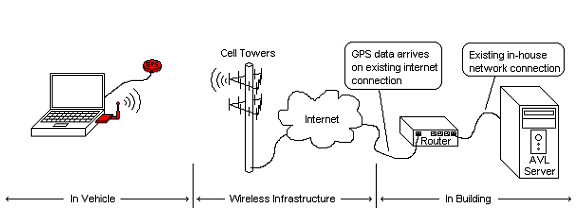
|
Example GPS Configurations |
Standalone cellular modem with built-in GPS reporting
•Operates reliably.
•Works with dynamic or static IP addressed modems.
•Tracks without a computer in vehicle.
•Some provide Internet access to optional devices in vehicle.
•Requires cellular data service plan.
•Limited to cellular coverage in the agency's area.
Most cellular modems transmit a modem ID along with every GPS report that they transmit to the server. The AVL Server can use this ID to identify which vehicle the report came from. If the agency's equipment is not capable of transmitting an ID or if it is not set up that way, then it is required that the GPS modems have static IP addresses so that Think AVL can reliably know where each report came from.

Generic cellular modem with AVL Client and internal/external GPS device
•Requires AVL client software installed on a computer and a GPS device connected.
•Works with off-the-shelf USB GPS or internal GPS devices that support NMEA over a COM port.
•Requires cellular data service plan.
•Limited to cellular coverage in the agency's area.
•Works with dynamic or static IP addressed modems.

Radio Frequency Modems
•May work on existing two-way radio infrastructure either sharing voice channel or on dedicated data channel.
•Sometimes the only option in rural areas with poor cellular coverage.
•No cellular charges.
•Low bandwidth compared to cellular. Report rates can be as slow depending on number of vehicles.
•GPS data arrives at AVL Server typically on a serial port connection, however, some radio vendors convert it to TCP/IP and send it to the network.
Consult the radio vendor and WTH for additional information on setting up the radio modems to report their GPS locations to Think AVL.

Other IP Networks
With a GPS receiver and a laptop, the AVLClient software can be used to send GPS reports to the AVL Server across just about any IP network assuming that the AVL Server has a static IP address visible to all laptops and the network allows UDP packet transmissions on the port used by AVL Server.

Receive GPS input from other AVL Systems
If another system is already in place for monitoring vehicle locations, it is often possible to configure that system to share, or re-transmit, this live data to Think AVL. This can distribute the fleet locations to all Think GIS maps and make use of the history reporting and other tools in Think AVL. Contact WTH for more information.

See Also:
|
Copyright © 2025 |